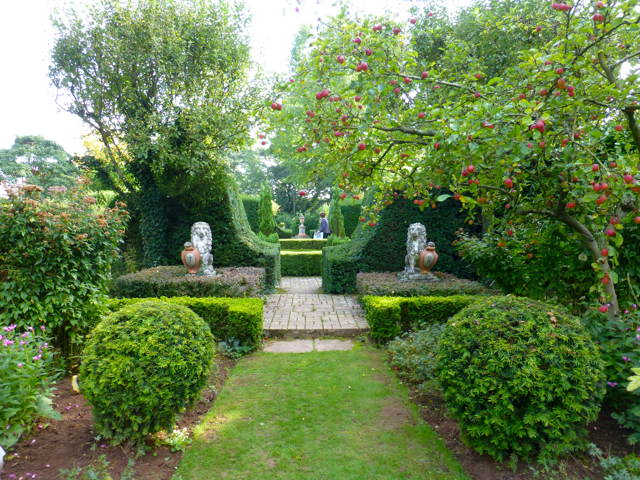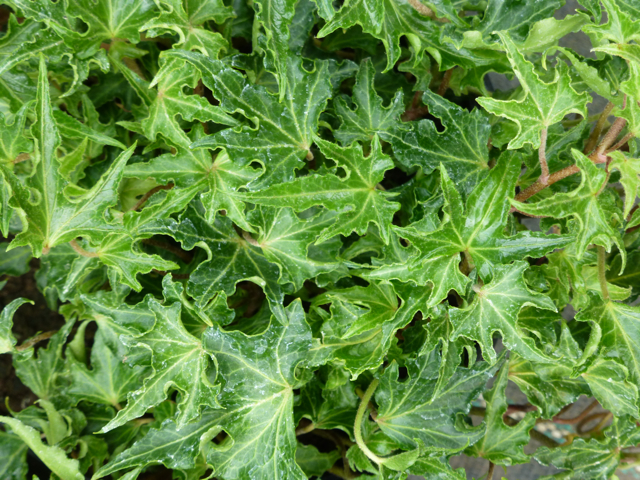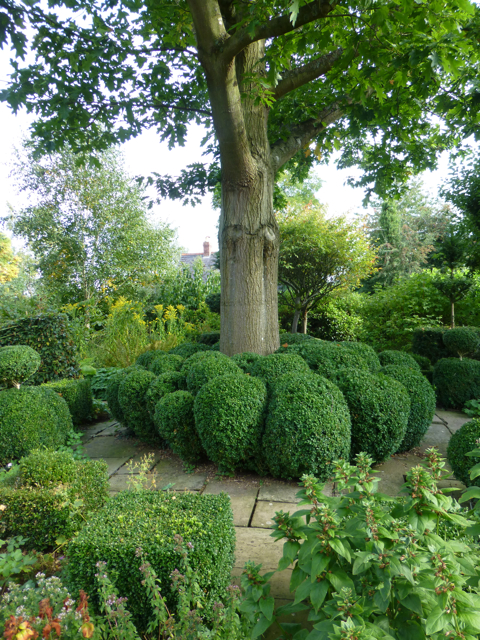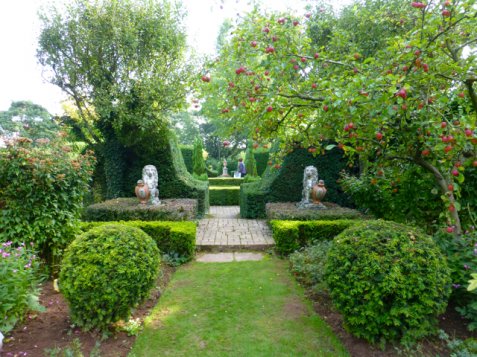December weather lays bare the bones of the landscape and reminds keen gardeners of the delights of monochrome gardening. Knock out colour - except greens - and think texture, movement, leaf contrast - all those things that design tutors at college chant as a mantra.  Last autumn, a group of us visited The Laskett in Herefordshire. This is Sir Roy Strong’s theatrical creation of an outdoor space. The drama is in the greens and topiary. It is an all-year round picture as the photo above shows. The plant palette, ever green. So which to choose? As Christmas looms, my mind turns to holly and ivy. Both are native plants - One is scratchy and the other has a reputation for smothering and strangling. With a glass of wassail-cheer on hand, read on and reconsider. First, ivy. I have seen it used as a clothing ‘fabric’ in the gardens of Palais Royal, deep in the heart of Paris. This space is very formal, stylish and pared down. Not floriferous in any season, it is strictly divided by pleached trees and a clever sort of ersatz hedge. This is the fedge - at no costs look this word up in the Urban Dictionary.
Last autumn, a group of us visited The Laskett in Herefordshire. This is Sir Roy Strong’s theatrical creation of an outdoor space. The drama is in the greens and topiary. It is an all-year round picture as the photo above shows. The plant palette, ever green. So which to choose? As Christmas looms, my mind turns to holly and ivy. Both are native plants - One is scratchy and the other has a reputation for smothering and strangling. With a glass of wassail-cheer on hand, read on and reconsider. First, ivy. I have seen it used as a clothing ‘fabric’ in the gardens of Palais Royal, deep in the heart of Paris. This space is very formal, stylish and pared down. Not floriferous in any season, it is strictly divided by pleached trees and a clever sort of ersatz hedge. This is the fedge - at no costs look this word up in the Urban Dictionary.  In horticultural language, a fedge is a way of having the privacy but without the sideway-sag of the usual hedge. Stick up some well-strained chain-link fencing and grow something close-clinging. Ivy is the ideal candidate. It will take time to get going though, give it a couple of years to get roots tucked in before making serious top growth. The National Collection of hederas (that is ivy in Latin) holds more than 300 types. There are subtle and glorious variants: tricoloured, leaves of all shapes and cultivars that colour up in winter. Try these cultivars: for white splashes - Hedera helix ‘White Ripple’, for a crispy, curly look - Hedera helix ‘Ivalace’ or Hedera helix ‘Pittsburgh’ for dark winter coloration. Ivy is a forgiving plant. Grow it in shade, sunlight, dry ground or sopping wet and, given time, it will clamber and heft itself skywards. Once it gets going, it self-clings and as we all know, is evergreen. Ivy does not deserve a bad name and I would recommend a look at the website of Fibrex nurseries, holders of the collection. Here is an example of what it can do: I own the ugliest garden seat in Suffolk. I asked Angela, Fibrex nursery owner what to do: “No problem; plant 4 Hedera pastuchovii Ann Ala round its base and give it 3 years”. The eyesore (and it’s nasty arch) will be covered, can be sat on and will provide a visual foil to the browned off leaves of the hornbeam hedge behind it. An excellent sort of recycling. A search for the National Collection of hollies on the other hand ended in a dry old corner. How many varieties? “over 160 accessions, representing 44 species and subspecific taxa”. A few more facts follow. Holly is a woodland plant and puts up with shade. It is one of our most common natives. Apart from keeping the intruder at bay, pretty much all forms of the plant have leaves that throw up reflections and shine in low winter light. Most types will need a male and female of the species in order to get berry production going. A harmonious companion planting would be ferns, snowdrops and hellebores; all of the wood and therefore associate well. Bear in mind that holly is a slow grower. Now how about taking a post mince-pie moment to consider Niwaki?
In horticultural language, a fedge is a way of having the privacy but without the sideway-sag of the usual hedge. Stick up some well-strained chain-link fencing and grow something close-clinging. Ivy is the ideal candidate. It will take time to get going though, give it a couple of years to get roots tucked in before making serious top growth. The National Collection of hederas (that is ivy in Latin) holds more than 300 types. There are subtle and glorious variants: tricoloured, leaves of all shapes and cultivars that colour up in winter. Try these cultivars: for white splashes - Hedera helix ‘White Ripple’, for a crispy, curly look - Hedera helix ‘Ivalace’ or Hedera helix ‘Pittsburgh’ for dark winter coloration. Ivy is a forgiving plant. Grow it in shade, sunlight, dry ground or sopping wet and, given time, it will clamber and heft itself skywards. Once it gets going, it self-clings and as we all know, is evergreen. Ivy does not deserve a bad name and I would recommend a look at the website of Fibrex nurseries, holders of the collection. Here is an example of what it can do: I own the ugliest garden seat in Suffolk. I asked Angela, Fibrex nursery owner what to do: “No problem; plant 4 Hedera pastuchovii Ann Ala round its base and give it 3 years”. The eyesore (and it’s nasty arch) will be covered, can be sat on and will provide a visual foil to the browned off leaves of the hornbeam hedge behind it. An excellent sort of recycling. A search for the National Collection of hollies on the other hand ended in a dry old corner. How many varieties? “over 160 accessions, representing 44 species and subspecific taxa”. A few more facts follow. Holly is a woodland plant and puts up with shade. It is one of our most common natives. Apart from keeping the intruder at bay, pretty much all forms of the plant have leaves that throw up reflections and shine in low winter light. Most types will need a male and female of the species in order to get berry production going. A harmonious companion planting would be ferns, snowdrops and hellebores; all of the wood and therefore associate well. Bear in mind that holly is a slow grower. Now how about taking a post mince-pie moment to consider Niwaki?  This is the Japanese art of the close pruned tree. Similar to Bonsai but on a bigger scale. Branches are bent down to give, by artifice, the look of nature diminished or subtly altered. The most perfect examples of these trees with elliptical branches formed to look like fluffy clouds are achieved with Ilex crenata Convexa, known as Japanese Holly. The leaves are very small - no bigger than those of the box plant. Ilex crenata is uncommon here but used more widely in America as a box substitute in areas with harsh winters. (One more in the armoury against box blight?) The Romantic Garden Nursery in Norfolk grows and trains these plants. For trees of a real size, Architectural Plants, down in Sussex have Niwaki ilex at prices that reflect that they are slow, slow growers and bought in from Japan. Consider them as living antiques. Of course, other trees and shrubs can be treated to the special pruning -Phillyrea latifolia (a European native) and Myrtus apiculata are examples. I, for one, will accept no substitute for a Japanese holly Niwaki-worked tree in my stocking. This article first appeared in Essential Suffolk, December 2013.
This is the Japanese art of the close pruned tree. Similar to Bonsai but on a bigger scale. Branches are bent down to give, by artifice, the look of nature diminished or subtly altered. The most perfect examples of these trees with elliptical branches formed to look like fluffy clouds are achieved with Ilex crenata Convexa, known as Japanese Holly. The leaves are very small - no bigger than those of the box plant. Ilex crenata is uncommon here but used more widely in America as a box substitute in areas with harsh winters. (One more in the armoury against box blight?) The Romantic Garden Nursery in Norfolk grows and trains these plants. For trees of a real size, Architectural Plants, down in Sussex have Niwaki ilex at prices that reflect that they are slow, slow growers and bought in from Japan. Consider them as living antiques. Of course, other trees and shrubs can be treated to the special pruning -Phillyrea latifolia (a European native) and Myrtus apiculata are examples. I, for one, will accept no substitute for a Japanese holly Niwaki-worked tree in my stocking. This article first appeared in Essential Suffolk, December 2013.
